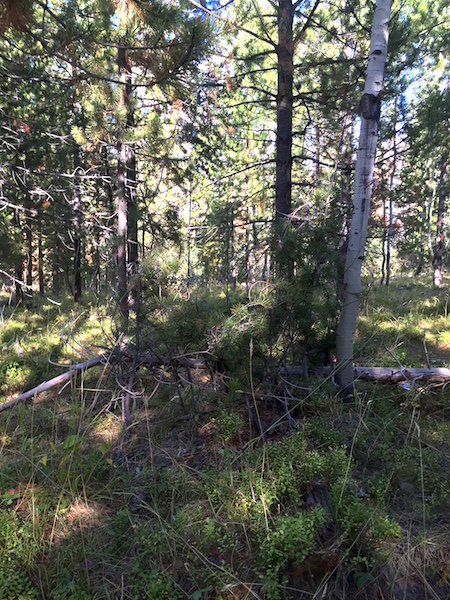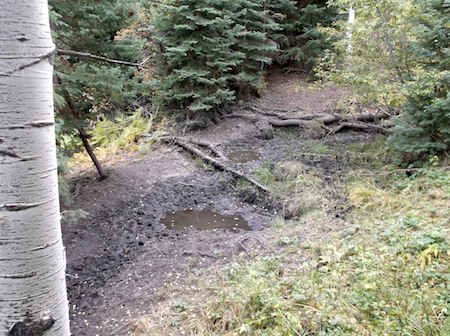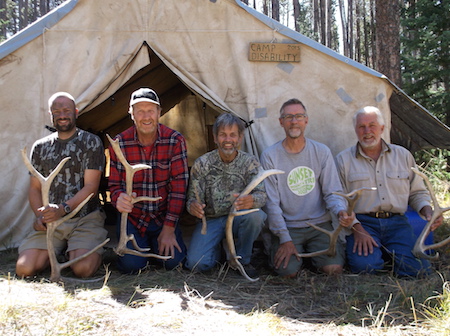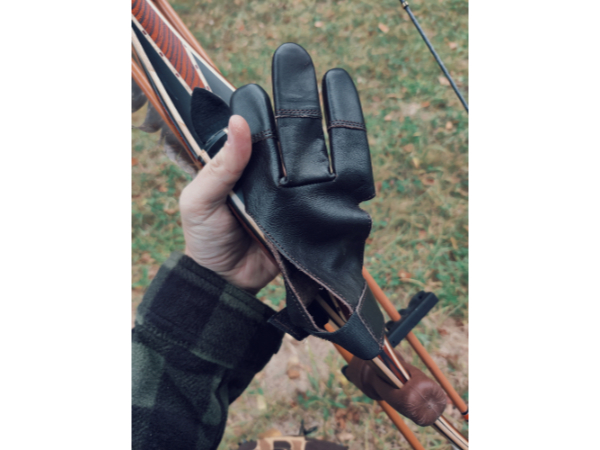He stared at me, straight through me it seemed, as I crouched in the soft undergrowth, nearly in fetal position gripping my longbow behind a primitive blind made of dead sticks and pine bough tips. The odd mesh of sticks and pine needles may have seemed a bit strange to him, but more of a curiosity than a threat. The slightly nervous 3 x 4 muley buck calmed and turned broadside, only seven yards from my little hiding place. I didn’t move, not a twitch, and remained crouched and silent except for the pounding in my ears due to the affect of adrenaline on my heart. Two yards behind the 3 x 4 stood a grand muley buck hefting a towering atypical rack, serenely browsing, unaware of any danger.

The buck’s view of the primitive blind made of sticks and twigs.
I had never hunted mule deer, and have little experience hunting whitetail in my native Wisconsin forests. I hunted with my dad using a Herter’s Match Hunter recurve and wood arrows forty some years ago; eagerly, but incompetently roaming local fields and forests in pursuit of any deer I could sneak upon. After a couple years, I gave up hunting as other pursuits replaced the diminishing enthusiasm I had for hunting. Girlfriends, academics, sports, and later a career and family, all extinguished any flicker of remaining desire. In the meantime, the technology of archery had changed dramatically. Compound bows with cams and stabilizers, sites and trigger releases, carbon arrows with lighted nocks, climbing stands, range finders, scent locking camouflage apparel, and HD trail cameras from which you could download the images remotely while sitting comfortably in a lounge chair in front of your flat screen TV all became standard equipment. I loved the out of doors, but none of this technological advancement appealed to me. I found other activities and interests meeting my desire to interact with the natural world. Family sailing and backpacking, skiing, fishing, and winter camping filled my leisure time until the kids had all left home to pursue education and careers and families of their own.
Then, about six years ago, my friend, colleague, and accomplished archery hunter, Don Roepke, asked if I might be interested in traditional archery. “What’s that?” I responded. Don explained by recounting his journey back to the simplicity and beauty of a hunt devoid of most modern archery technological advancements, and the acute awareness of the senses involved in the whole experience of close encounters in pursuit of the majestic whitetail buck. He told me of a retro world of traditional tools, just a longbow or recurve and arrows, devoid of gadgets, a world that requires an intimacy with the natural environment seldom fully realized in the midst of high tech hunting. “How close can I get?” begins to replace “How far can I shoot?” Shooting accuracy is still essential, but close encounters are too.
I took the bait, dug my forty-year-old Herter’s recurve out of storage, and joined Don in a winter traditional archery league. The learning curve was steep for shooting alone, not even considering the knowledge required to hunt deer with any chance of success. I progressed well enough to try hunting the next fall season. That season and the next I wounded two bucks because of poor shooting and not realizing my effective shooting distance. Fortunately, the wounds were superficial and not life threatening, but these failures devastated my enthusiasm and confidence. I vowed I would not hunt again without improving my accuracy and sense of distance.
Armed with a new longbow, and improved accuracy within twenty yards, I continued to hunt the forests near home: learning the behavior of whitetail does and bucks, finding likely pinch points for concentrated travel, and noting the often unwary antics of a buck during the rut. Then, last fall, I again learned a hard lesson. I had set a tree stand ten yards south of a fresh scrape along a ridge trail overlooking a small lake reflecting the fiery red maples, and yellow poplars, with dark green towering white pine and steeple shaped spruce interspersed among the browning oaks. I was late as I climbed into the tree stand–the sun already climbing above the tree line in the east–too late to have much hope of encountering a buck. Thirty minutes later, I glimpsed movement about fifty yards to the west. A nice six-point buck was nibbling his way through young poplars and along the trail toward the scrape beneath me. A light wind maintained its flow from the northwest. Perfect. Slowly and silently, the young buck continued on, closer and closer. I stood when I saw his head was down behind some brush, and waited patiently for the moment of decision: when the angle was right, the distance was within my confidence of accuracy, and the prey was calm. He stopped and stood broadside over the scrape, and lifted his head up to rub the twig end above the scrape. I drew, aimed, and released, confident in a ten-yard broadside shot. THWAK! The buck bolted to the east, full tilt and I lost sight of him seventy-five yards away. I had hit him high…at twelve yards!

An elk wallow that brought smiles of anticipation to my fellow elk hunters.
I sat in my stand for thirty minutes, agonizing over the poor shot, sick with remorse and contempt for my incompetence, again! I descended the oak tree below my stand and began a miserable search for a buck I knew I had wounded mortally, but likely would never find. I tracked him for an hour and a half, winding randomly in a large semi-circle to the east, then north, and then west, back to the ridge northwest of my tree stand. Halfway down the ridge bank, the trail of scant blood drops and occasional footprints dead-ended. About this time, I heard the engine of an ATV start, and saw a beagle dog near the bottoms. Backtracking a short distance, I found tracks and blood where the buck seemed to have bounded down the bank to the swampy bottom among tag alder and white pine. I followed to the bottom and found the end of the trail, a small area of matted swamp grass stained with blood, and a gut pile nearby. I scratched my head, not understanding the scene before me. Again, I backtracked a short distance and noticed a well-hidden tree stand about fifteen yards from the trail. After some slow-minded contemplation, I was hopeful as I realized the events that had likely occurred while I waited in painful reflection in my tree stand prior to descending to track the wounded buck.
My deductions were confirmed after I found a nearby ATV trail that led to a house on the other side of the lake, where a beagle greeted me at the driveway and an ATV sat in the open garage. I subsequently was able to talk to the young hunter that lived there. Yes, he had shot a wounded six-point buck, and just returned from transporting it to the processor. He had noticed the buck was injured, and decided to take it. He also told me the reason the young buck bounded down the hill and past his stand was due to an encounter with a much bigger buck half way up the hillside. The young hunter now had fresh venison to feed his young family, and I was overwhelmed with relief. I could have hugged him. I thanked and congratulated him, and told him how grateful I was that he was able to harvest the buck I had wounded. Then I spent the rest of the day questioning whether or not I should ever hunt again. I drove home, climbed into my practice tree stand, and shot three arrows into a 3-D target I used almost exclusively at twenty yards. All three were good shots. I climbed down and moved the target to within ten yards of the tree, climbed back up and shot an arrow. I hit the target high, near the upper scapula. How could I have been so ignorant? If you are going to shoot at a deer from ten yards, then you should practice the shot from ten yards. I had heard similar words before. This was a hard lesson.
This year, Don invited me on a hunt in southern Wyoming in the Sierra Madre range of the Medicine Bow National Forest. I would hunt mule deer while the other four in camp would hunt elk or both. At first I was reluctant to accept, feeling too inexperienced, unworthy of such a hunt. Eventually, I accepted the invitation, knowing my fellow hunters would provide ample advice and assistance along the way. I drew a mule deer permit and vowed I would diligently practice shooting during the weeks prior to our departure. My left shoulder decided otherwise, leaving me nearly disabled, incapable of shooting more than two or three arrows in a “practice” session. Don suggested I rest for a couple weeks, meaning no practice. Inexplicably, I was able to shoot without discomfort ten days later. I practiced shooting from the ground at twelve, fifteen, and twenty yard intervals with an occasional twenty-five yard shot. I imagined a shot from a kneeling position at fifteen to twenty yards might be the most likely shot presented, and I felt fairly confident at those distances. Now, however, I found myself in a ridiculous scene, within seven yards of the 3 x 4 muley, broadside with his head in the pine boughs, and the enormous atypical right behind him.

The hunters with elk sheds discovered along the way to and from camp. We all endured some physical limitations, providing plausible excuses for missed opportunities, so we dubbed our base “Camp Disability”.
The light wind had maintained a westerly direction for several minutes, but had been unpredictable most of the afternoon. Now, it stayed in my favor. The two bucks had meandered toward me, giving me some time to calm down and respond to various potential shooting opportunities. “They’re getting too close! Move away!” “They’re so close, one of them will surely pick up my scent any second!” “How will I be able to rise to my knees and shoot without one alarming the other?” “Will you get out of the way so I can shoot your big partner!?” As the smaller buck turned broadside, he blocked any possible shot at the big atypical. The big buck, positioned nearly head on and two yards behind the 3 x 4, reached up into the foliage of an adjacent tree, his massive antlers entwined within hanging boughs. Now or never, I thought; I’ll take the 3 x 4. I rose to my knees, slowly and silently, drew, aimed, and released. Whump! That sounded good, like a deep penetration through the thorax. The young buck bolted northeast and the massive buck disappeared to the south. I watched the fletched end of my arrow crack off and fall to the ground as the young buck careened through the trees. I lost sight of him forty yards away, but heard him crash and break brittle deadfall branches as he ran beyond my line of sight into a gully running east of the water hole.
I was worried. The shot looked clean…but maybe a bit too forward. It sounded good…but the arrow did not pass through. I fretted with anxiety and self-doubt for forty minutes as I waited, hoping the shot was true and the kill was clean. At last, I began tracking along the forest floor where the buck’s attempt to escape was running through my mind like a video on replay. I failed to find the broken arrow, but found spots of blood on a deadfall near my last sight of the racing buck. Then I found splotches, larger as I followed the trail, finally finding him down and dead about eighty yards from the point of my shot. I felt humbled and in awe of the magnificent wild creature that lay before me, an innocent creature that gave me sustenance and life. I pondered this fact and thanked God for His creation and provision.
A clean double lung shot was confirmed later as we processed the venison in the field. I had learned many things through this hunt, and in the preparation. Close encounters can be difficult, and if one may experience a close shot, then it may be a good idea for one to practice the close shot. But seven yards? Yes, though it may seem ridiculous, even seven yards.
Author’s biography: When Dave isn’t hunting, he and his wife, Lynne, enjoy fishing, sailing, hiking, and kayaking in Wisconsin.
Equipment note: Dave used a RER Vortex 2 64″ longbow, and a Beman “Center Shot” arrow tipped with a Muzzy Phantom 4-blade broadhead.







Leave A Comment